
Leptospermum is a genus of shrubs and small trees in the myrtle family Myrtaceae commonly known as tea trees, although this name is sometimes also used for some species of Melaleuca. Most species are endemic to Australia, with the greatest diversity in the south of the continent, but some are native to other parts of the world, including New Zealand and Southeast Asia. Leptospermums all have five conspicuous petals and five groups of stamens which alternate with the petals. There is a single style in the centre of the flower and the fruit is a woody capsule.

Alectryon is a genus of about 30 species of trees and shrubs from the family Sapindaceae. They grow naturally across Australasia, Papuasia, Melanesia, western Polynesia, east Malesia and Southeast Asia, including across mainland Australia, especially diverse in eastern Queensland and New South Wales, the Torres Strait Islands, New Guinea, the Solomon Islands, New Caledonia, New Zealand, Vanuatu, Fiji, Samoa, Hawaii, Indonesia and the Philippines. They grow in a wide variety of natural habitats, from rainforests, gallery forests and coastal forests to arid savannas and heaths.

Leucopogon is a genus of about 150-160 species of shrubs or small trees in the family Ericaceae, in the section of that family formerly treated as the separate family Epacridaceae. They are native to Australia, New Zealand, New Caledonia, the western Pacific Islands and Malaysia, with the greatest species diversity in southeastern Australia. Plants in this genus have leaves with a few more or less parallel veins, and tube-shaped flowers usually with a white beard inside.

Beyeria is a genus of shrubs and small trees in the family Euphorbiaceae known as turpentine bushes. It was first described as a genus in 1844. The entire genus is endemic to Australia.

Eriocaulon is a genus of about 400 species commonly known as pipeworts, of monocotyledonous flowering plants in the family Eriocaulaceae. The genus is widely distributed, with the centers of diversity for the group occurring in tropical regions, particularly southern Asia and the Americas. A few species extend to temperate regions, with ca. 10 species in the United States, mostly in the southern states from California to Florida, and only two species in Canada; China has 35 species, also mostly southern. Only one species occurs in Europe, where it is confined to the Atlantic Ocean coasts of Scotland and Ireland; this species also occurs in eastern North America and is thought to be a relatively recent natural colonist in Europe. In the Americas, Eriocaulon is the only genus in its family that occurs north of Florida. They tend to be associated with wet soils, many growing in shallow water, in wetlands, or in wet savannas like flatwoods. In wet soils, their abundance appears to be related to water levels, fire frequency, and competition from other plants such as grasses. Experiments have shown that they are weak competitors compared to many other wetland plant species. Some species can persist as buried seeds during unfavorable conditions. The scientific name is derived from Ancient Greek εριον, erion, meaning 'wool', and καυλός, caulos, meaning 'stalk'.

Kunzea is a genus of plants in the family Myrtaceae and is endemic to Australasia. They are shrubs, sometimes small trees and usually have small, crowded, rather aromatic leaves. The flowers are similar to those of plants in the genus Leptospermum but differ in having stamens that are longer than the petals. Most kunzeas are endemic to Western Australia but a few occur in eastern Australia and a few are found in New Zealand. The taxonomy of the genus is not settled and is complicated by the existence of a number of hybrids.

Isotoma is a genus of annual and perennial herbs in the family Campanulaceae and are native to Australia and New Zealand.
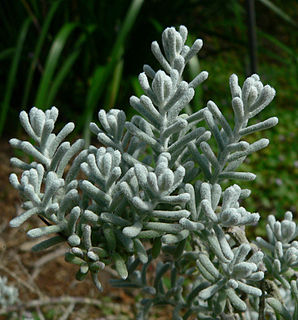
Maireana sedifolia, also known as the bluebush or pearl bluebrush is a compact shrub endemic to Australia, and found in New South Wales, Victoria, South Australia, Western Australia, and the Northern Territory. It is used in pasture and as a garden plant where it is popular due to its distinctive grey foliage.

Ricinocarpos is a plant genus of the family Euphorbiaceae first described as a genus in 1817. The entire genus is endemic to Australia.

Xanthostemon is a genus of trees and shrubs, constituting part of the myrtle plant family Myrtaceae. This genus was first described in 1857 by German–Australian botanist Ferdinand von Mueller. According to different official sources between 46 and 51 species are known to science. They grow naturally in New Caledonia, Australia, the Solomon Islands and Malesia, including the Philippines, New Guinea and Indonesia. The genera Pleurocalyptus and Purpureostemon from New Caledonia are morphologically close to Xanthostemon.

Lepidosperma is a genus of flowering plant of the family Cyperaceae. Most of the species are endemic to Australia, with others native to southern China, southeast Asia, New Guinea, New Caledonia and New Zealand.
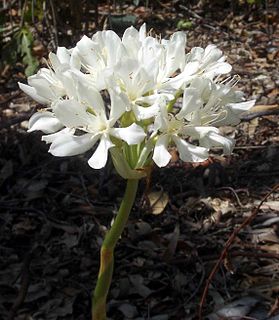
Proiphys is a genus of herbaceous, perennial and bulbous plants in the family Amaryllidaceae, subfamily Amaryllidoideae. It includes 5 accepted species that are native to Southeast Asia, Papuasia, and Australia.
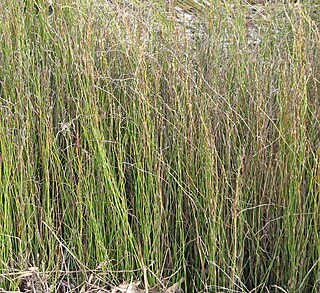
Lepyrodia is a plant genus in the family Restionaceae, described as a genus in 1810.

Laxmannia is a genus of tufted perennial herbs in the family Asparagaceae, subfamily Lomandroideae, that are endemic to Australia.
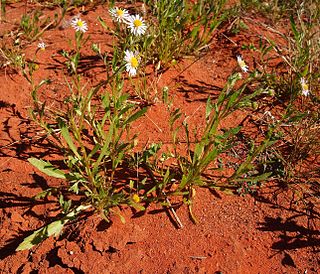
Vittadinia is a genus of Australian and New Zealand plants in the aster tribe within the daisy family.
Wendlandia psychotrioides is a species of shrubs or small trees, constituting part of the plant family Rubiaceae.
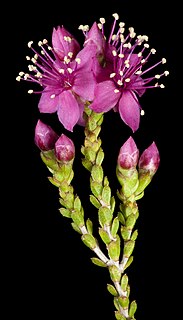
Homalocalyx is a genus of shrubs in the family Myrtaceae described as a genus in 1857. The entire genus is endemic to Australia.

Nymphoides crenata, commonly known as wavy marshwort, is an aquatic perennial herb of the family Menyanthaceae endemic to Australia, found in all mainland states and the Northern Territory

Abutilon oxycarpum, known as flannel weed, straggly lantern-bush, and small-leaved abutilon, is a malvaceous plant native to eastern Australia. It is found on hillsides or floodplains on red sand and limestone.

Scaevola collaris is a shrub in the family Goodeniaceae and its native range is five mainland states/territories of Australia: the Northern Territory, New South Wales, South Australia, Queensland and Western Australia.



















